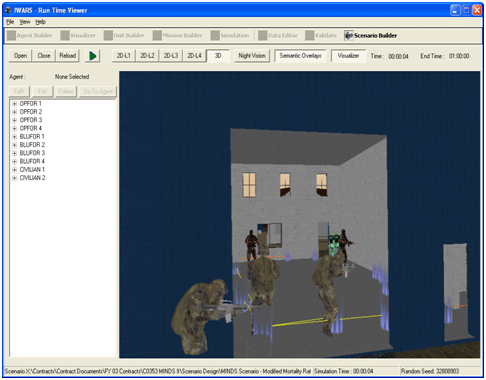Charles River Analytics, a developer of cutting-edge technologies for intelligent systems, announces its continuing support for the U.S. Army’s Infantry Warrior Simulation (IWARS) modeling and simulation (M&S) program through multiple contract awards, all aimed at improving the simulation of soldiers and small combat units so IWARS can be used to provide better operational effectiveness assessments.
Dr. Peter Weyhrauch, Senior Scientist at Charles River Analytics, explained, “Our goal is to improve the realism and fidelity of a simulation, especially from a cognitive point of view so that fundamentals like, ‘should we maneuver along this corridor or through that valley?’ can be realistically exercised in simulations. We’re not talking about simply making the avatars look more realistic; we’re talking about making them behave more realistically. Improved behavior representation will significantly enhance the ability of IWARS to assess the impact of equipment and concepts on Command & Control and Situation Awareness.”
IWARS development is being led by the Natick Soldier RD&E Center (NSRDEC) and the Army Materiel Systems Analysis Activity (AMSAA) to model the effects of new technologies and equipment, support the development and acquisition of new equipment for the PEO Soldier program, and support the development of new tactics, techniques, and procedures (TTPs). Use of simulations can augment formal test and evaluation, support major acquisition decisions, and better focus the investment choices of limited Research and Development dollars on equipment that has greater impact for the soldier.
Charles River’s most recent M&S effort for the Army is Uncertainty-Modeling Rules for Situational Awareness (URSA), under contract with the U.S. Army Research, Development and Engineering Command (RDECOM), awarded in May 2010. The two-year contract (including its predecessor feasibility study) is valued at $850,000. URSA addresses modeling uncertainty in ground soldiers’ situation awareness and its effects on decision making in battlefield situations. URSA can be used in constructive simulations, such as IWARS, to determine the impact of information and information accuracy/certainty on critical soldier decisions. Through IWARS, URSA also supports the Army in acquiring the best possible equipment to support collaborative situation awareness.
URSA, embedded in IWARS, models decision making under uncertainty: “If there are shooters in the yellow building, maneuver right (option 1); if there are shooters in the green building, maneuver left (option 2).”
In a related contract called Modeling UDOPs within Simulated Environments (MUSE), Charles River is addressing a key need for the U.S. Army in managing the information soldiers receive through User Defined Operation Pictures (UDOPs), a technique for pushing and pulling information that provides the soldier with critical information available from Army networks. The UDOP can present role-specific information or mission-specific information, or it can allow the soldier to configure what is presented to maximize his task performance and ultimately mission success. However, designing these UDOPs can be difficult, and this is where MUSE comes in. MUSE will permit IWARS to evaluate the impact of different UDOP strategies on operational effectiveness through factors such as timeliness, update rates, and relevance.
MUSE uses automated analysis techniques to determine what information the soldier needs to perform effectively, as well as provide tools to analyze the soldier’s resulting performance in constructive simulations like IWARS. Further, MUSE is designed to make it straightforward to create algorithms that determine what information is shown and when, and then to easily port those algorithms to operational UDOPs being used in the field. MUSE is funded by NSRDEC; it received initial and follow-on awards running from 2007 until 2011 with a combined value in excess of $800,000.
Both URSA and MUSE are built on the rule-based technology developed in the Graphical Authoring Tool for Inference Rules (GATIR) project, a recently completed contract. GATIR allows a simulated soldier to take a specific data element and link it to other data elements to transform ground-truth to perceptions that the soldier uses in understanding the situation. In GATIR, Charles River focused on modeling a soldier’s inferences and associations, such as determinations of the danger posed by external threats, which form part of a soldier’s cognitive process that determine behavior choices. One of the key results of this effort was an easy-to-use, general-purpose modeling tool that has been used and enhanced under the URSA and MUSE contracts to create models of uncertainty and UDOP logic.
In a predecessor contract, Modeling Individual Differences and Stressors in Human Cognitive Performance (MINDS), Charles River used an M&S-based approach to account for the effects that behavior moderators (BMs) have on cognitive performance. MINDS focused on individual differences to represent variations in behavior across individuals and environmental stressors to vary an individual’s responses according to situations.

Charles River demonstrates MINDS behavior moderators using IWARS
Steve Marotta, the lead Software Engineer on the project, explained, “Traditionally, agents respond to factors in their external environment. In MINDS, agents respond to a combination of external factors and internal conditions, such as anxiety, fatigue, aggression, caffeine, or inexperience, as influences on how they will behave. For example, if an agent is inexperienced and fatigued, he or she might hesitate. Or, if an agent is angry and fatigued, he or she may react impulsively and fire upon a friendly or civilian target.”
Dr. Scott Neal Reilly, Vice President of Decision Management Systems at Charles River Analytics, said, “We have had the pleasure to work with the Modeling and Analysis team at NSRDEC for almost eight years now. They do extremely important work bringing state-of-the-art M&S capabilities to bear on real-world problems and we are excited that this relationship will continue under the latest URSA project. We could see work being done on behalf of the Modeling and Analysis Team utilized on other development programs being conducted at NSRDEC specifically related to Soldier decision aids.”
